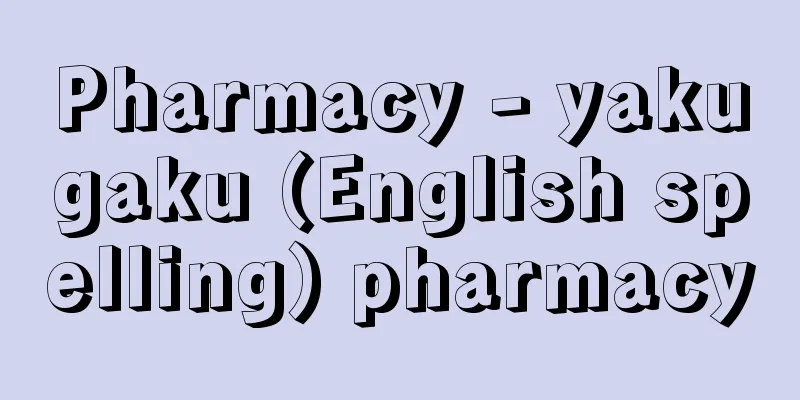Pharmacy - yakugaku (English spelling) pharmacy

|
There have been many different opinions and debates about what kind of science pharmacy is, but there is agreement that it is an academic field that studies chemical substances in relation to human health. Pharmacist Yosouji Ito (1909-1976) defined it as "a science that aims to maintain and improve human health and treat diseases, and that aims to achieve this goal primarily through related substances," and the "White Paper on Pharmaceutical Research" defines it as "a comprehensive science that aims to create, manufacture, and manage medicines." Drugs have physical or physicochemical aspects in addition to chemical and biological aspects, and the introduction of these has had a major impact on the discovery, development, and manufacture of new drugs. However, all of these are substance-oriented or pharmaceutical-oriented, and the work of hospital pharmacies, such as adjusting, managing, and evaluating drugs, should be patient-oriented. As a result, the field of clinical pharmacy or medical pharmacy has rapidly developed in the United States and other countries around the world as one direction of pharmacy. Japanese pharmacy was originally an academic field that developed mainly around organic chemistry, and drugs were treated first as chemical substances. As a result, organic chemistry and natural product chemistry developed to a high level, but there was a lack of interaction with the field of drug treatment, which is clinical medicine. Originally, pharmacy arose as a branch of medicine, where doctors made diagnoses and compounded medicines. However, in Europe in 1240, Holy Roman Emperor Frederick II issued the Medical and Pharmaceutical Law, separating medicine from medicine and prohibiting doctors from owning pharmacies. In Japan, pharmacy was merely a prerequisite for medical training until the end of the Edo period, but after the Meiji Restoration, it was influenced by European medicine, and in 1873 (Meiji 6), the First University District Medical School (later the University of Tokyo) was established with a pharmaceutical department and taught pharmacy. This was the first pharmacy education at a university. The following year, the Medical System was promulgated, and specialized drug store owners (later renamed pharmacists) were established, creating a profession of pharmacy. Thus, pharmacy was separated from medicine, and the reasons for this include the increasing need for technicians with specialized knowledge to identify and create medicines in response to the prevalence of substandard medicines. In Europe, pharmaceutical education has been conducted through apprenticeship in pharmacies since ancient times, and in the 18th century, the duties of pharmacies included (1) dispensing and selling medicines prescribed by doctors, (2) manufacturing medicines, and (3) providing public health guidance to local residents. This is similar to the current functions of pharmacists. Japanese pharmacy has made outstanding achievements in basic chemistry, including organic chemistry, and has recently been active in the development of highly effective medicines. However, medical pharmacy is lagging behind Europe and the United States, and practical training in medical pharmacy (also called hospital pharmacy) is not yet mandatory. On the other hand, as medicines have progressed and developed, many side effects have appeared, becoming a social problem. Therefore, pharmaceutical information activities such as collecting, organizing, and transmitting information on medicines have developed into a field of pharmacy, and social pharmacy has newly emerged. These are being researched, including hygienic chemical aspects such as pollution caused by chemicals and food additives. The school pharmacist system is also a new field for pharmacists to play an active role, helping to improve the environment surrounding schools and maintain the health of students. The purpose of pharmaceutical education is not only to train pharmacists, but also to train researchers and educators. [Fumiji Koho] Pharmaceutical EducationThe University Accreditation Association, in its pharmaceutical education standards, divides specialized education subjects into basic pharmacy and applied pharmacy, and provides detailed information. In other words, the basic pharmacy field consists of three areas: organic chemistry, physical chemistry, and biology, while the applied pharmacy field consists of four areas: pharmaceutical science, medical pharmacy, hygiene pharmacy, and applied common. Basic pharmaceutical subjects include organic chemistry, natural product chemistry, reaction organic chemistry, organic synthetic chemistry, structural organic chemistry, bioorganic chemistry, coordination chemistry, and inorganic chemistry in the organic chemistry field; analytical chemistry, physical chemistry, radiochemistry, instrumental analysis, biophysical chemistry, quantum chemistry, and physical chemistry in the physical chemistry field; and biochemistry, functional morphology, medicinal plant biology, microbiology, microbial chemistry, immunology, pathology, pathological biochemistry, and histochemistry in the biology field. Applied pharmacy subjects include, in the pharmaceutical sciences field, Pharmacology, Drug Manufacturing, Introduction to Chemical Engineering, Formulation Science, Quality Control, Biopharmaceuticals, Drug Testing Methods, and Biological Testing Methods; in the medical pharmacy field, Pharmacology (including compounding), Pharmacology or Pharmacology, Introduction to Clinical Medicine, Pharmacology, Introduction to Hospital Pharmacy, Drug Management, Pharmacy Management, Drug Metabolism and Pharmacokinetics, Radiopharmacy, and Clinical Chemistry; in the hygiene pharmacy field, Hygiene Chemistry (including public health), Toxicology, Food Hygiene Chemistry, Introduction to Environmental Science, Forensic Chemistry, and Hygiene Testing Methods; and in the applied common field, Japanese Pharmacopoeia, Pharmaceutical Affairs Law and Regulations, Introduction to Pharmacy, Pharmaceutical Information Science, and General Overview of Pharmaceuticals. It is also recommended that students complete a hospital internship or equivalent training. [Fumiji Koho] "Outside Pharmacy: A Message from Pharmacy to the Public" edited by Yasumasa Koyama (1987, Yakugyo Times) " "Japanese Pharmacy" by Soyoko Nemoto (1981, Nanzando) [Reference] | |Source: Shogakukan Encyclopedia Nipponica About Encyclopedia Nipponica Information | Legend |
|
薬学とはいかなる学問であるかということについては、これまで種々の見解が出され論議されてきたが、化学物質を人間の健康との関係から研究する学問分野である点では一致している。薬学者の伊藤四十二(よそじ)(1909―76)は「人の健康の保持増進と疾病の治療を目的とし、主としてこれに関連する物質を通じて、この目的に到達するための学問」と定義しており、また『薬学研究白書』では「医薬品の創製、製造、管理を目標とする総合科学」と定義している。 薬物には化学的・生物学的側面のほか、物理的あるいは物理化学的側面もあり、これらが導入されて新薬の創製、開発、製造に大きな影響をもたらした。しかし、いずれも物質志向型ないし医薬志向型であり、薬剤の調整、管理、評価といった病院薬局での業務は患者志向型であるべきもので、薬学の一つの方向として臨床薬学ないし医療薬学という分野が、アメリカをはじめ世界各国で急速に発展してきた。日本の薬学は、もともと有機化学を中心として発展してきた学問であり、薬物をまず化学物質として取扱い、そのため有機化学および天然物化学が高度に発展したが、臨床医学という薬物治療の現場との交流が欠けていた。 元来、薬学は医学の一部門として発生し、医師が診断して薬の調合もしていた。しかし、ヨーロッパにおいて1240年、神聖ローマ皇帝フリードリヒ2世は医薬令を公布し、医と薬を分離して医師の薬局所有を禁じた。日本では江戸時代の終わりまで、薬学は医学修業の前提とされていたにすぎないが、明治維新後にヨーロッパ医学の影響を受け、1873年(明治6)第一大学区医学校(後の東京大学)に製薬学科を設けて薬学を教授した。これは大学における最初の薬学教育である。翌年には医制が公布され、専門の薬舗主(のちに薬剤師と改称)を創設して薬学の専門職業人をつくった。こうして薬学が医学より分離したわけであるが、その要因としては、不良医薬品の横行に対する専門知識をもった技術者による鑑別、医薬品創製の必要性が増大したことなどがあげられる。 ヨーロッパでは古くから薬局において徒弟制度による薬学教育が行われ、18世紀には薬局の業務として(1)医師の処方による調剤および販売、(2)医薬品の製造、(3)地域住民に対する公衆衛生の指導が行われている。これは現在の薬剤師の職能に通ずるものである。日本の薬学は有機化学をはじめとする基礎化学分野において優れた業績を残しており、最近では創薬の面においてもきわめて有効な医薬品の開発が活発であるが、医療関係の薬学が欧米より遅れており、医療薬学(病院薬学ともいう)についての実地研修がまだ義務づけられていない。一方、医薬品の進歩発展に伴ってその副作用も多く発現、社会問題化している。したがって、医薬品に関する情報の収集・整理・伝達といった医薬品情報活動も薬学の一分野として発展し、ここに社会薬学が新しく登場した。これらは化学物質による公害、食品添加物など衛生化学的な面も含めて研究が行われている。また、学校薬剤師制度は新しい薬剤師の活躍の場で、学校を取り巻く環境の整備、生徒の健康保持に役だっている。なお、薬学教育は、薬剤師の養成のみならず、研究者や教育者の養成もその目的とする。 [幸保文治] 薬学教育大学基準協会では、薬学教育基準として専門教育科目を基礎薬学と応用薬学に分け、詳細に示している。すなわち、基礎薬学分野は有機化学、物理化学、生物学の三つの系、応用薬学分野は製薬学、医療薬学、衛生薬学、応用共通の4つの系から成り立っている。 基礎薬学の授業科目としては、有機化学系では有機化学・天然物化学・反応有機化学・有機合成化学・構造有機化学・生物有機化学・錯体化学・無機化学など、物理化学系では分析化学・物理化学・放射化学・機器分析学・生物物理化学・量子化学・物性物理化学など、生物学系では生化学・機能形態学・薬用植物学・微生物学・微生物化学・免疫学・病理学・病態整理学・病態生化学・組織化学などがあげられる。 応用薬学の授業科目としては、製薬学系では生薬(しょうやく)学・薬品製造学・化学工学概論・製剤学・品質管理学・生物医薬品学・医薬品試験法・生物学的試験法など、医療薬学系では薬剤学(調剤学なども含む)・薬理学または薬物学・臨床医学概論・薬物治療学・病院薬学概論・医薬品管理学・薬局管理学・薬物代謝および薬物速度論・放射薬品学・臨床化学など、衛生薬学系では衛生化学(公衆衛生学を含む)・毒性学・食品衛生化学・環境科学概論・裁判化学・衛生試験法など、応用共通系では日本薬局方・薬事関係法規・薬学概論・医薬品情報科学・医薬品総論などがあげられ、さらに病院実習またはこれに準ずる研修を履修させることが望ましいとされている。 [幸保文治] 『小山泰正編『薬学外論―薬学から市民へのメッセージ』(1987・薬業時報社)』▽『根本曽代子著『日本の薬学』(1981・南山堂)』 [参照項目] | |出典 小学館 日本大百科全書(ニッポニカ)日本大百科全書(ニッポニカ)について 情報 | 凡例 |
Recommend
Katen
Gagaku. Left side. Ichikotsu chord. Shingaku. Four...
Fraxinus lanuginosa (English spelling)Fraxinuslanuginosa
… [Yukio Taniguchi]. … *Some of the terminology t...
cruise missile
...Furthermore, based on these missile technologi...
Anaxarchos
…from Elis. He started out as a painter, then stu...
Intaglio - Ohan
In contrast to letterpress printing, this type of ...
Emancipation of Perpetual Property Ownership - Eitaishoyuzaisankaihorei
...For this reason, military men such as Esparter...
Signatologia
… The “Book of Nature” is the name for the unwrit...
Oksongni Historic Site - Oksongni Historic Site (English)
Located in Okseok-ri, Wolrong-myeon, Paju-gun, Gye...
A young woman's relationship - Onna no wakanaka
...an age group of young women that was once form...
Yamagata-Rovanov Agreement
The Japan-Russia Protocol on the Korean Problem wa...
Asada Birdie - Asada Birdie
…He called himself Afghan, but was born in Iran. ...
Freie University zu Berlin (English)
...There are approximately 2,000 teachers and 31,...
Gazami fujitsubo - Gazami fujitsubo
...Other known barnacles include the striped turt...
garde-manger
…The saucier is responsible for all meat dishes a...
Harriman, William Averell
Born: November 15, 1891 in New York [Died] July 26...









